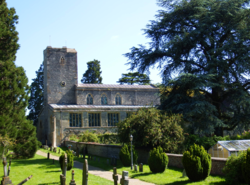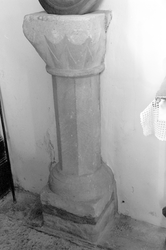
The Corpus of ROMANESQUE SCULPTURE in Britain & Ireland

Worcester (medieval)
Parish church
Preston Bagot is a small, dispersed village in the Stratford district of Warwickshire, 6 miles W of Warwick. The church is on the N side of the settlement and is built of grey limestone rubble. It consists of a nave with a W bell turret and S porch, and a chancel with a N vestry. The nave and chancel are largely 12thc, but the church was restored by J. A. Chatwin who lengthened the chancel, added the chancel arch, heightened the walls and added the timber bell-turret in 1878-79. The N nave wall retains its doorway and 3 plain lancets, all of the 12thc. The S doorway is also recorded here.
Parish church, formerly Benedictine house
St Mary's, Deerhurst is certainly the most imposing, enigmatic and controversial Anglo-Saxon building in the county, and perhaps the whole country. It retains features from several periods of Anglo-Saxon building, covering the period (depending on which version of its history you prefer) from the 7thc to the 11thc. Putting the standing evidence together into a believable building sequence is by no means straightforward. The general reader who has prepared for a visit to the church might well be surprised to find any post-Conquest material there at all, but the interior is dominated by the late-12thc nave arcades that will be the main subject of this report.
An oversimplified version of the story is that the earliest church, predating the first mention of a monastery here in 804 might have been a rectangular box with a W porch. This church was greatly enlarged in a second phase of building, usually assumed to correspond to the late-10thc reform movement. Porticus were added alongside the nave, and a polygonal apse was added at the E end. The nave was raised at the same time to its present height of approximately 12m, and a chancel was carved out of the rectangular nave by the insertion of a cross wall. Around this time too, the W porch was given extra stioreys to convert it into a tower porch (although this may have been done in several phases). After the Conquest - perhaps as late as 1190 - the porticus flanking the nave were replaced by aisles with 3-bay arcades. The S aisle was later (but still in the 12thc) fitted with transverse arches carried on responds abutting the nave arcade piers. The plan included here, displayed inside the church, shows one interpretation of the building phases.
What survives, therefore, is a church with a chancel, aisled nave and a W tower porch. The aisles extend W alongside the tower, and a passage linking them, W of the central vessel, forms a kind of W transept. Remains of 12thc work survive here, notably in a section of foliate stringcourse of the W wall of the passage. The W end of the N aisle now houses Deerhurst's famous font; presented as a work of 9thc art in its own right, dramatically lit from below. This report is provisional, as access to the upper levels of the tower was not available at the time of the visit.
Parish church
Brailes is a village in the Sratford on Avon districty of S Warwickshire, 8 miles E of Banbury. The village is divided into Upper (E) and Lower (W) Brailes, and the church is on the N side of Lower Brailes High Street. It is a large church of coursed ironstone with a tall W tower, an aisled nave with a S porch, and a chancel with a N vestry. It is largely of 1325-72 with a 15thc tower, and was restored by William Smith from 1877-79. He rebuilt the chancel arch and the N aisle and clerestorey. The vestry was enlarged 1892-93. None of the fabric is Romanesque, but there is a section of an interesting carved shaft loose in the church.
Parish church
Coates is a small settlement about 2.5 miles NNW of Kemble. The church lies to the W of the village and has a chancel, a nave, a S aisle with a porch, and W tower; there are two projecting chapels on the N side, one on the chancel and one on the nave. The church is approached from the N.
Surviving Romanesque sculpure are a 12th-c S doorway, a reset chancel arch and a font.
Parish church, formerly Benedictine house
Tewkesbury lies at the northern tip of Gloucestershire, adjacent to the county border with Worcestershire. It is around 15 miles south of Worcester and 10 miles north of Gloucester. The town itself is located on the east bank of the River Avon, at the point where the Avon meets the River Severn. Tewkesbury Abbey stands south of the town centre on a quasi-peninsula formed by the confluence of the River Swilgate, which runs from the east, with the Avon. The area has been prone to flooding over the centuries and especially in recent years. Fortunately the abbey stands on a slightly elevated point, although this has not fully protected the building from flood damage.
Tewkesbury Abbey is regarded as one of the most important Romanesque buildings in the British Isles due to its architectural features and the state of preservation. The church has a cruciform plan comprising an 8-bay aisled nave (with additional 9th bays at the west end of the aisles), aisleless transepts with east-projecting chapels, and a 2-bay chancel flanked by an ambulatory with radial chapels. All of the ambulatory chapels are later medieval constructions. Many alterations were made to the E arm and vaulting throughout the church during the 14thc. There was originally a cloister to the S of the nave as well as other claustral buildings, however these were demolished after the Dissolution.
The abbey was restored by Sir George Gilbert Scott between 1865 and 1879. During this period, the stone screen dividing the nave from the crossing and E arm was removed. One bay of the cloister was reconstructed by Thomas Collins at the end of the 19thc and the W front was repaired in 1906. Various projects were carried out between 1932 and 1938, including repairs to the tower and the strengthening of pier foundations. The site of the E ambulatory Lady Chapel was excavated in 1940 by Sir Charles Peers and Thomas Overbury (the footprint of this structure is marked out on the grass at the E end of the abbey). Major repairs were made to the abbey roofs between 1978 and 1985. The roofs of the eastern chapels were repaired between 1994 and 1996. Repairs were made to the W nave turrets between 1999 and 2002.
Chapel
The hamlet of Postlip is located between Winchcombe and Bishops Cleeve on the east edge of the Cotswolds. St James’ Chapel is located within the Postlip Estate, immediately north of Postlip Hall at the top of an embankment. The chapel is a small 12th-c two-cell structure constructed from ashlar masonry. Later additions include the late Perpendicular windows to the east and west of the building, and the late 19th-c sacristy north of the nave. The most notable Romanesque survivals are the south nave doorway and the chancel arch. In addition, there are four round-headed slit windows in the following locations: south nave wall (east of the south doorway), south chancel wall, north chancel wall, and north nave wall; all, however, are internally and externally devoid of sculptural decoration.
Chapel
The first approx. 3m of height of the rectangular building is of 12thc. masonry for the most part. The E and W windows, now blocked, can be seen. Floors have been inserted and partitions made over centuries. It is still easy to see the ground plan of what may have been the 12thc. church.
Ruined parish church
All that remains of the church is the buttressed, three-stage 12thc. tower and part of the S transept including a 14thc. N arcade. The S transept was restored in 1835 for use as a mortuary chapel. The tower has a twin pointed bell-opening ofc.1200 (Pevsner refers to them asc.1200 twins.) on the highest stage of the W face with a shared mullion within a round-headed, chamfered arch. There is a round-headed window of two orders on the second stage and a further deeply splayed round-headed window set into a buttress on the S face, heavily restored. The only Romanesque sculpture is on the corbels supporting the tower arch.
Parish church
The 12thc fabric includes an aisleless nave, N doorway with tympanum, chancel arch and font. There is considerable herringbone masonry in the N and S walls of the nave (GL13/30). The chancel was entirely rebuilt in the 13thc, and a S transept added in c.1300. The blocked S doorway (GL13/30) probably replaces an earlier doorway in the same position.
Parish church
Mainly 18thc. and consisting of nave, chancel and a 13thc. W tower on S side of church. There is Herringbone work inside chancel N wall and outside chancel S wall, and a plain, flattened round arch but these may be 18thc. (Pevsner). Romanesque sculpture is found on the pillar piscina.









